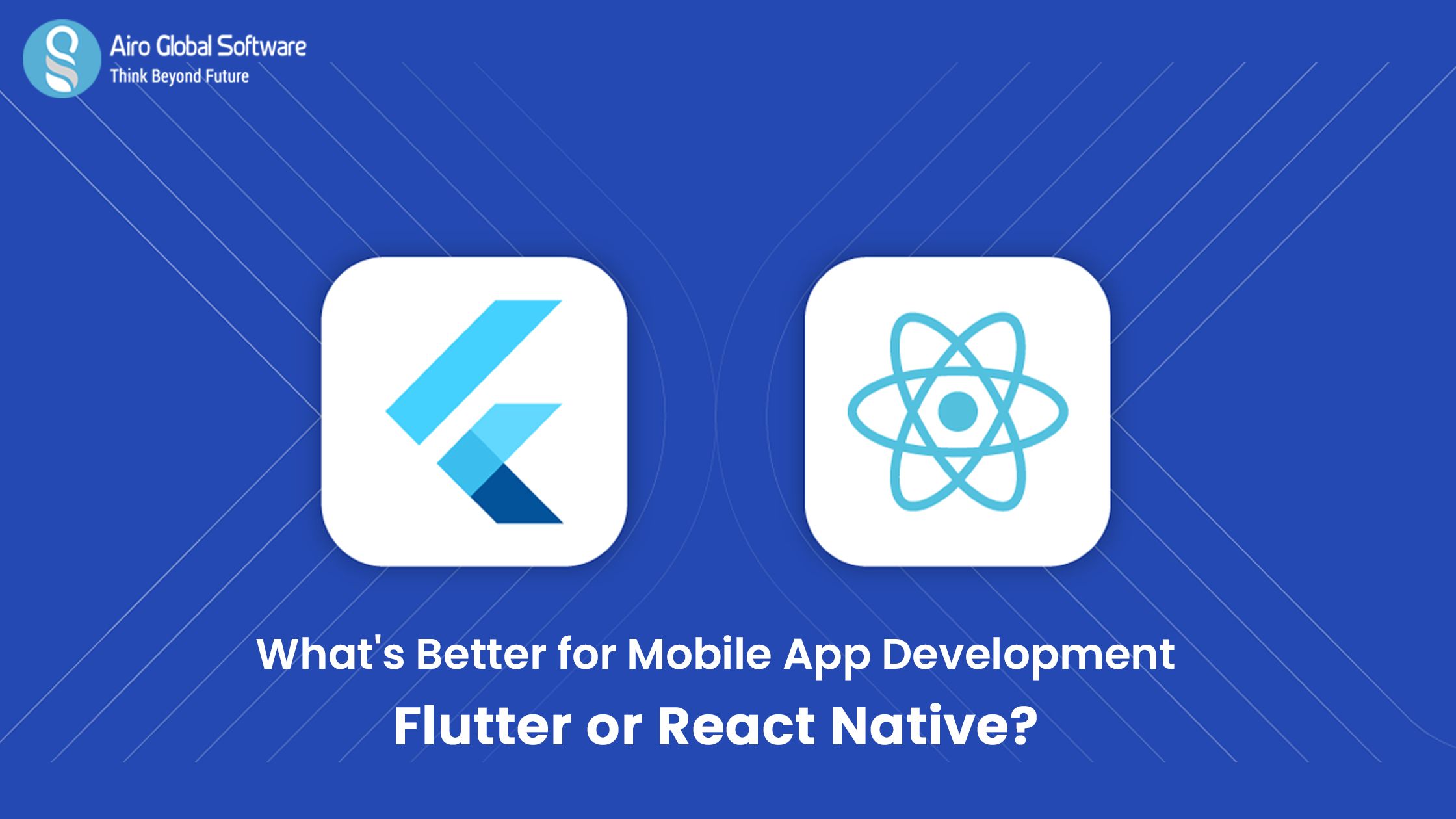Many businesses now have the opportunity to create an app because development services are now available to small businesses, but an overwhelming number of apps fail. Among other things, the technology you use is an important success factor. Choosing a low-performing language or framework can drastically reduce your chances of success. Airo Global Software, the best mobile app development company in Kerala will help you to provide a better choice for your application.
Flutter app development in Kerala, In this blog, we will discuss the advantages and disadvantages of Flutter, as well as the most relevant use cases. We'll go over what a Flutter app is and how developing apps with Flutter tools can help you build a successful product.
What is Flutter?
Before delving into the benefits and drawbacks of this cross-platform technology, let's look at the definition of Flutter. What exactly is Flutter, and why are we discussing it today? Flutter is a Google open-source technology that allows developers to create mobile, web, and desktop applications with a single codebase that can be used across multiple platforms. Because it is not a library or framework that is used in conjunction with other technologies, but rather a UI software development kit, the technology is a goldmine for cross-platform app development (SDK).
A library is a collection of code that can be used in an app to perform a specific function, whereas a framework serves as a structure for the future app by providing you with tools to complete the architecture. An SDK is a collection of tools, such as libraries, frameworks, documentation, APIs, and so on, that allow you to create a fully functional application.
Flutter is frequently compared to other programming languages and frameworks, including React Native, Xamarin, and even Kotlin.
Why flutter?
What exactly is Flutter app development in Kerala, and how can it help you achieve your business objectives? In this section, we'll look at the benefits of Flutter and try to figure out why so many businesses choose to use this technology for cross-platform app development.
- Cross-platform App Development
If you're new to app development in Kerala, you might feel overwhelmed by the amount of information available on how to create an Android app or launch an iOS app. So, why not create apps for both iOS and Android at the same time? Flutter gives you access to simple cross-platform mobile app development tools that are designed to save you time and reduce the headaches that come with developing two apps at the same time. Your job will be much easier with a single codebase for both platforms.
- It’s Fast, Fast, Fast
When it comes to mobile app development in Kerala, time is of the essence. Flutter refers to this as "hot reloading" and defines it as follows: Flutter's hot reload feature allows you to experiment, build UIs, add features, and fix bugs quickly and easily.
The Flutter framework automatically rebuilds the widget tree after the VM updates classes with new versions of fields and functions, allowing you to quickly see the effects of your changes. Take it a step further and consider how much it benefits the developer-designer relationship. For example, your designer can instruct your Flutter engineer to "move five pixels to the left." The update is then immediately available, allowing the designer to determine if it's the right look.
- Support for Older Devices
It's a major concern for all developers, especially now that updated operating systems are being pushed out to users on a regular basis. Your app will look the same with Flutter, even if it's running on older versions of Android and iOS. This is significant for several reasons: And there are no extra fees for supporting older operating systems with Flutter.
- Top-notch user experience
Flutter app development in Kerala is the process of creating applications using ready-made widgets. In comparison to other common approaches such as layouts, views, or controllers, Flutter's widget technique provides a consistent object model and an easy-to-use development process. In Flutter development, everything you touch is a widget, and widgets can be combined to create more complex layouts.
- Cost efficiency
Money will be saved as a result of a shorter development cycle, fewer developers, and reduced complexity. As a result, you will be able to release two apps for Android and iOS more quickly and on a smaller budget.
- Google guaranteed
Google guarantees years of support for Flutter apps because the company uses the technology itself. You can be certain that Google will continue to fix bugs, release new versions, and contribute to technology to the greatest extent possible. Flutter app development in Kerala is involved in many Google projects, including Google Fuchsia, proving that Flutter will be around for a long time.
- Elevated performance
Even at the iOS Summit in 2017, Flutter outperformed Xamarin and React Native:
- Flutter vs React Native
In comparison to Flutter's 58fps and 220ms, React Native achieved 57fps and 229ms.
- Great MVP builder
MVPs have become a must-have for any startup because they can assist you in validating your idea and obtaining the initial funding for your project. MVPs are small, basic app versions with key features that are simple to create and launch. They exist to put the concept to the test and gather early feedback in order to make a better app in the next iteration. Companies that do not have an MVP have a difficult time finding investors and must go into development blindly. Flutter app development in Kerala is an excellent choice for an MVP because the SDK is extensive, simple to understand and learn, and produces high-quality apps. Are there any potential disadvantages? We use the term potential because any perceived disadvantage of Flutter can be overcome with the proper approach.
- Lack of support
Even though Flutter has made strides in this area since its inception, there is still much to be desired. If you're looking for help, you can find some of it on the Flutter website, but you're probably better off looking for it on social media and third-party forums.
- Platform limitations
In general, there are some constraints, forcing developers to devise "workarounds." For example, while it is simple to implement a video player in Flutter, it does not look the same when deployed. On the plus side, there is a solution for all of these constraints; you just need to find the right one.
When should you use flutter and when should you avoid it? What is the purpose of Flutter app development? What kinds of applications can be created with the Flutter programming language Dart, and why? We already know that Flutter development produces aesthetically pleasing interactive apps that can run on a variety of operating systems. Let's take a look at the most appropriate types of applications you can create with Flutter.
Types of Applications
- Gaming apps
Flutter, as we've seen, outperforms most frameworks with 58 frames per second. High performance is critical for a successful app, especially in the gaming industry. Users will become very frustrated and abandon your app if your games do not run smoothly and quickly. Flutter app development is an excellent choice for creating a high-performance gaming app as well as incorporating cutting-edge AR features.
- On-demand apps
On-demand applications are one of the most popular app development markets. People were unable or restricted from going out to buy food, medicine, clothes, and other necessities, especially during quarantines. On-demand applications found their potential here. Flutter app development provides native-like performance, exceptional design, and a great user interface, making it the market's go-to technology.
- Photo editing apps
Flutter app development in Kerala enables you to create photo editing applications with user-friendly interfaces and personalised recommendations. With an increasing number of people having accounts on Instagram and other social media platforms, having a simple tool to polish photos is almost a requirement. And Flutter is the ideal tool for creating an easy-to-use app with advanced features.
What else can Flutter do? Another trend in the mobile app world is machine learning (ML), which enables personalization and accurate sales forecasting. The technology has grown in popularity over the last decade, and Flutter development allows you to incorporate ML into your app. Flutter includes a plugin, firebase ml vision 0.9.7, that provides access to Firebase's machine learning features and kits. Even inexperienced Flutter developers can use this kit to add ML components to their applications, such as face or speech recognition.
- Google Ads
Google Ads Mobile is a mobile version of the web application that allows you to work on your ad campaigns even when you are not connected to your computer or laptop. Even though the mobile version is not as comprehensive as the web version, it does provide access to statistics, bid and budget updates, helpful alerts, and keyword modification. Finally, to stay on top of things, you can contact a Google expert and ask questions about the programme. The application was created with Flutter and has an appealing and user-friendly interface.
- Reflectly
Reflectly, an AI-driven app based on cognitive behavioural therapy and meditation, is another solution on the list of apps built with Flutter. The app is dedicated to assisting users in dealing with day-to-day stress and remaining positive in the face of adversity. The development of a Flutter app enabled the creation of a high-performance application with real-time updates and alerts, as well as valuable insights into dealing with mental health crises.
- Xianyu
Xianyu is a sales-boosting app created for the Alibaba corporation. Flutter development resulted in an app that can handle hundreds of millions of monthly users while maintaining excellent speed and performance. Flutter apps are fast, robust, and scalable, which is why the astute Alibaba team chose this technology and did not make a mistake.
- Postmuse
With Instagram's unprecedented popularity, a plethora of supporting tools and apps have been released. Postmuse is a Flutter-based app that offers templates and editing options for Instagram stories and photos. The app is also AI-powered, and it recommends the best image to enhance your Instagram profile.
- Pairing
Pairing is a dating app developed by Dart. Pairing, which was created with Flutter, provides the best performance and native feel for both Android and iOS platforms. Users are matched based on their real-world connections and communities.
Conclusion
Flutter app development in Kerala enables businesses to create native-like apps on a smaller budget and simultaneously launch them on both the Android and iOS operating systems. DOIT Software has chosen Flutter as its primary technology. As a Flutter app development company in Kerala, we are here to assist you in achieving your business objectives and developing the best app for your needs. If you have any questions about the above issue, please contact us. Please do not hesitate to get in touch with us. Your digital partner will be Airo Global Software.
E-mail id: [email protected]

Author - Johnson Augustine
Chief Technical Director and Programmer
Founder: Airo Global Software Inc
LinkedIn Profile: www.linkedin.com/in/johnsontaugustine/





 Author - Johnson Augustine
Author - Johnson Augustine



 Author - Johnson Augustine
Author - Johnson Augustine